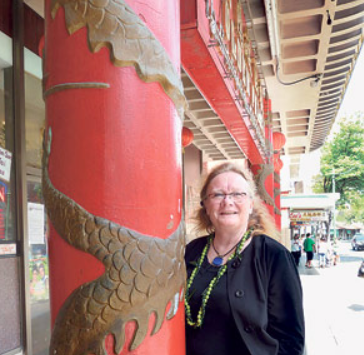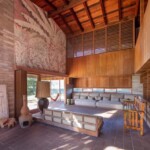By Shayna Yatsuhiro, guest contributor

Spencer Leineweber in 2011 (courtesy: AIA Honolulu)
In 1996, a group of 66 walkers met at Kamānele Park to join a tour organized by Mālama Mānoa. Strolling for a couple miles through verdant Mānoa, the group was eager to view and learn more about the historic homes that had stood in the neighborhood since the 1920s and 1930s. Leading the group was Spencer Leineweber, a professional architect, longtime educator, and Mānoa resident by way of New Jersey. On this inaugural walk, Spencer spoke to the unique architectural properties and special qualities of the stately houses along their route. Her depth of knowledge and commitment to telling the stories of Hawai‘i’s special structures and places was to establish this as one of Mālama Mānoa’s most popular events, but this was just a small taste of Spencer’s commitment to Hawai‘i’s communities and histories.
In addition to her work at Mālama Mānoa, Spencer and her husband Michael were original charter members of the Historic Hawai‘i Foundation in 1974 and remained at the forefront of preservation efforts throughout their lives. Spencer received HHF’s 5th Annual Frank Haines Award for Lifetime Achievement in 2013. Additionally, Spencer gave walking tours around Honolulu’s Chinatown district and served in numerous leadership roles in professional and community organizations, including serving as a juror for the UNESCO Asia-Pacific Heritage Awards. She served as the Director of the University of Hawai‘i at Mānoa’s Heritage Center and was a prominent professor in the School of Architecture, where she also served as the Chair of the graduate program. Today, UH’s Hamilton Library holds a large collection of Spencer’s work materials from 1977-2015, including field notebooks, photos, and drawings.
As an architect, Spencer was known for her research-driven accuracy and thoughtfulness. Her professional historic preservation work led her to special locations like Iolani Palace, early 20th-century estates on the Big Island, and Hawai‘i’s Plantation Village. Her work on this latter Waipahu-based site won an American Institute of Architect’s National Design Honors award. Spencer played a pivotal role in developing this new outdoor museum and she published a short article (“Havai‘i’s (sic) Plantation Village”) which provides a glimpse into her approach. Using measured drawings from contemporary sources, Spencer helped to replicate, repair, and preserve buildings representing Chinese, Portuguese, Puerto Rican, Japanese, and Filipino immigrants at the time of each group’s arrival to the islands. The buildings she worked on reflected specific architectural techniques, transitioning building styles that were meeting different laborer needs (including the shift from communal dorms and facilities for single male laborers to small individual residences as families began to arrive), and specific cultural practices, including a Japanese tofu-ya (tofu manufacturer) and a structure for a Portuguese bread oven.
Spencer dove deeply into understanding the world as experienced by the communities that lived in the structures she sought to preserve and replicate. At the same time, she had to work with the very modern challenges of historic interpretation and incorporating grassroots input. She continued to blend technical architecture expertise with her deep interest in the people inhabiting significant spaces as she wrote her PhD thesis on how 19th-century Native Hawaiians defended the integrity of their indigenous spaces in the face of foreign influence and transformation. Time and again, her work returns to the history of Hawai‘i’s people and the fascinating stories about them and our past that are embedded and perpetuated in our historic places.
Spencer suddenly passed away in 2015 and the impact of her loss continues to be felt within the community. The impact she has had in Hawai‘i and beyond is still so tangible. In reflecting on the many architects who learned from her and the unique buildings that continue to stand today because of her, it is impossible to overstate her influence. Her work to thread continuity between our historic spaces and our present has defined a personal legacy that will be preserved far into our future.
Highlights of Spencer Leineweber’s Legacy

Hawaiian Mission Houses Museum and Archives: Spencer served as the historic architect for this 200-year-old site and supported preservation efforts there for over three decades. [Founding of the Mission Houses]
 The Jean and Zohmah Charlot House: Spencer wrote the historic structures report and treatment recommendations to preserve the Kahala home that renowned artist Jean Charlot co-designed and resided in with his family.
The Jean and Zohmah Charlot House: Spencer wrote the historic structures report and treatment recommendations to preserve the Kahala home that renowned artist Jean Charlot co-designed and resided in with his family.
The home was donated to the University of Hawai‘i at Mānoa and is protected by a preservation easement held with Historic Hawai‘i Foundation. The house serves as an educational site for the University of Hawai‘i Community Design Center at the School of Architecture.
 University of Hawai‘i at Mānoa Campus Heritage Report: The UH Mānoa centennial marked the start of Spencer’s year-long work on an unprecedented inventory of this campus’ historic architecture and landscaping. The report begins with the historical context of the campus; its heritage landscape; a survey of buildings and landscapes; conflicts between the campus’ Long Range Development Plan and the Heritage Report; and a description of preservation guidelines. [View the report]
University of Hawai‘i at Mānoa Campus Heritage Report: The UH Mānoa centennial marked the start of Spencer’s year-long work on an unprecedented inventory of this campus’ historic architecture and landscaping. The report begins with the historical context of the campus; its heritage landscape; a survey of buildings and landscapes; conflicts between the campus’ Long Range Development Plan and the Heritage Report; and a description of preservation guidelines. [View the report]
 Hawai‘i Plantation Villages: Spencer received a National Design Honors Award from the American Institute of Architects for conceiving and constructing this living history museum of plantation life and culture. [Visit the Hawai‘i Plantation Village’s website]
Hawai‘i Plantation Villages: Spencer received a National Design Honors Award from the American Institute of Architects for conceiving and constructing this living history museum of plantation life and culture. [Visit the Hawai‘i Plantation Village’s website]
 Chinatown and Downtown Honolulu, O‘ahu: Over thirty years, Spencer helped restore a number of historic buildings in downtown Honolulu (including the Kamehameha V Post Office on the corner of Merchant and Bethel pictured at left). In 2011 she led an AIA-sponsored walking tour of architecturally significant buildings in Chinatown, the oldest intact commercial area on the island.
Chinatown and Downtown Honolulu, O‘ahu: Over thirty years, Spencer helped restore a number of historic buildings in downtown Honolulu (including the Kamehameha V Post Office on the corner of Merchant and Bethel pictured at left). In 2011 she led an AIA-sponsored walking tour of architecturally significant buildings in Chinatown, the oldest intact commercial area on the island.
A Brief Biography
Spencer Leineweber, AIA was at the forefront of architecture and historic preservation in Hawai‘i for over 30 years. She earned an architecture degree from Cornell University, was a Fellow of the American Institute of Architects, a licensed Architect and a fifth-rank (top) instructor of the Ikebana Sogetsu. Her international recognition in the professional field of conservation architecture was gained from the full range of preservation activities. She was elected to FAIA in the American Institute of Architects in 1996 and was the 2011 President of the 700-member American Institute of Architects Honolulu. In 2013, she was recognized with the Frank Haines Award for Lifetime Achievement by Historic Hawai‘i Foundation.

